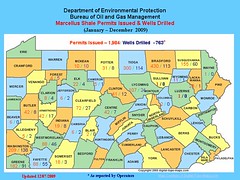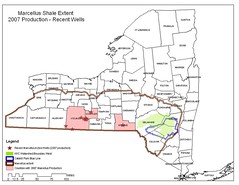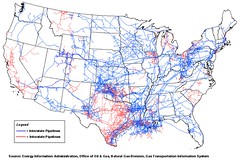By Jonathan Walters | October 2009
GOVERNING
Russia and the Middle East have, by far, the largest proved reserves of natural gas on the planet. But the Marcellus Shale Play, a mile-deep, rock-bound reservoir stretching through New York, Pennsylvania and West Virginia, is the closest approximation this country has. Experts have described it as “the most drilled but least explored” natural-gas basin in America. They say it could yield 400 trillion gallons of natural gas—20 times the current national annual output.
...
However, to get at the Marcellus gas, drilling companies have to employ a controversial boring technique that involves mixing water with a cocktail of sand and toxic chemicals and then injecting that at high pressure into shale more than a mile underground in order to fracture the rock and release the gas.
This process, known as hydraulic fracturing or “hydrofracking,” has been utilized before in several states. But environmentalists claim that it causes everything from earthquakes to above-ground explosions, that it can irredeemably pollute groundwater, and that it drains streams of the water that in many places is a resource as precious as the gas it’s helping to recover.
While the industry disputes that hydrofracking is the cause of such mayhem, nobody disputes that setting up wells is an intensive industrial procedure, and that the drilling process itself uses and pollutes huge amounts of water. A single well requires between 1 million and 5 million gallons of water. About 40 percent of what’s injected into the wells is pumped back out, and it comes out dirty and salty and needs to be treated before it is discharged back into public waterways. Pennsylvania already has reported incidences of unacceptably salty water from hydrofrack wells being discharged into rivers.
That is why the Marcellus Shale wars have been fully engaged, as the irresistible search for energy resources and riches collides with arguments over environmental disaster. The battle pits neighbor against neighbor, full-time residents against weekend homeowners, elected officials against elected officials and states against localities (some Upstate New York localities have enacted moratoria on drilling, something the natural-gas industry claims they don’t actually have the authority to do). Although the fracas over Marcellus Shale is regional, it serves as a cautionary tale for any place that encounters an unexpected energy boom.
As the conflict over hydrofracking rages, one question above all has surfaced: Who is responsible for ensuring environmental protection and public-health safety in the face of an avalanche of drilling-permit applications?
The answer to that question is complicated by two realities: Water does not respect jurisdictional boundaries, and the regulatory framework for hydrofracking is both fragmented and overlapping. Under such circumstances, the U.S. Environmental Protection Agency could provide clarity. However, in the 2005 Energy Policy Act, Congress exempted hydraulic fracturing from federal oversight.
So are states equal to the job? Some are scrambling just to catch up. The New York Department of Environmental Conservation (NYDEC), the agency that reviews and approves drilling permits statewide, has been caught at least a little flatfooted on Marcellus and hydrofracking. Governor David Paterson signed an industry-supported law last year related to the spacing of wellheads. Rather than evaluating the environmental impacts on a well-by-well basis, as is normally required under state law, NYDEC is studying the collective impacts of hydrofracking though what’s called a “generic environmental impact statement.”
The Pennsylvania Department of Environmental Protection (PADEP) seems more prepared, at least when it comes to regulating individual drill sites. PADEP already has received 450 applications for drilling permits, and is in the process of hiring nearly 40 new regulators, paid for in part by a significant increase in permit fees on hydrofrack wells.
But the New York and Pennsylvania regulators are not the only players with skin in the game. Powerful watershed compacts, including the Delaware River Basin Commission and the Susquehanna River Basin Commission, have their own permitting processes. Those kick in whenever anyone wants to draw significant amounts of water out of their watersheds or dump significant amounts back in.
Even New York City is claiming a role, because a huge portion of its internationally renowned source of sweet drinking water originates in the Catskill Mountain watershed, which sits hard by—and in some cases directly over—the Marcellus Shale Play.
“The reality is that the city has no power in this matter,” says Manhattan Borough President Scott Stringer. “But that doesn’t mean that a borough president or residents can’t be mobilized and create a buzz.” As part of his effort to create that buzz, Stringer’s office has produced a report that lists examples from all over the country of disasters—from earthquakes to exploding houses—blamed on hydrofracking.
New York City Councilman James Gennaro, a trained geologist who heads up the council’s environmental committee, believes that the surface impacts of drilling alone represent a prima facie case for an outright ban on drilling in any environmentally sensitive area. “Even if you didn’t inject one drop of ‘fracking fluid’ into the ground, just setting up the wellhead, with the drilling pad and all the trucking involved, are activities that will lead to the degradation of the city’s water supply,” says Gennaro. NYDEC, for its part, says that it won’t permit drilling in any watershed unless that watershed can be “fully protected.”
Scott Roberts, who heads up mining regulation in Pennsylvania, does not discount the challenge that his division faces. In particular, he says, cleaning up the polluted water “is the 800-pound gorilla here. Just pumping it back out and impounding it is not dealing with it.”
There has been some discussion in the industry of pumping the brine back underground, a solution that Carol Collier, executive director of the Delaware River Basin Commission, describes as “a little squirrelly.” Pennsylvania’s Roberts is similarly skeptical of a back-to-the-ground solution and thinks that ultimately industry itself is going to have to take the lead in building facilities to clean up the discharge water.
While Pennsylvania regulators and the river-basin commissions debate these issues, New York continues to work on its draft generic environmental impact statement. However, those both inside and outside of New York State government worry about NYDEC’s capacity to regulate drilling in the Marcellus Shale Play. The NYDEC division that oversees mining and drilling is one of the agency’s smallest sections. A request for 30 new staff members was stripped out of this year’s budget in the face of New York’s abysmal fiscal situation.
NYDEC refutes the characterization that it’s not up to the task of regulating hydrofrack wells. In an e-mail response to questions, an agency spokesperson noted that one out of 10 wells currently operating in New York were hydrofracked, and that so far there have been no adverse environmental impacts associated with any of them. As for the manpower shortage, NYDEC notes, “There have not been and will be no shortcuts in permitting—every well application will get all due scrutiny and oversight. The only impact of more staff would be that more permits could be processed in a given time period.”
It’s not a statement that inspires confidence among hydrofracking’s opponents, who would prefer that new staff be devoted to regulation rather than to pushing permits through the system. But given the fiscal realities, it will probably have to do. Even NYDEC’s critics agree that the Marcellus Shale Play is going to be extensively tapped one way or the other. The trick is going to be finding a way, despite budget shortfalls, to do it without compromising the environment or public health.
“When you look at it, we’re trying to walk a line,” says the Delaware River Basin’s Collier. “Clearly, there’s an economic benefit to the gas, and there’s value from the standpoint of national energy policy. But it is only going to be beneficial if it is done wisely and minimizes the impact to all natural resources.”
CLICK HERE for the complete artcle.
DEMAND ACCOUNTABILITY!



















Great post.
ReplyDeleteHere is my website ... www.quantrimtruth.com
Heya! I'm at work browsing your blog from my new iphone! Just wanted to say I love reading through your blog and look forward to all your posts! Keep up the outstanding work!
ReplyDeleteMy weblog :: http://www.bookmarks.elsecretodelaleydelaatraccion.com/
With this kind of operation, nothing gets destroyed.
ReplyDeleteBe sure to consult your doctor if you have a condition.
People also commented on its very powerful 800 watt motor that caused the juice to be very frothy.
Also visit my website - magic bullet with juicer and blender
I am really inspired along with your writing skills
ReplyDeleteand also with the format in your weblog. Is
that this a paid subject or did you customize it your self?
Anyway stay up the excellent quality writing, it's uncommon to see a nice weblog like this one nowadays..
My homepage; adiphenetruth.com
I have attempted to your prior 35 lots of a long time
ReplyDeleteto drop and Keep OFF my stomach body body fat. I've tried anything at all from diet regime regime capsules, personal trainers, just about each foods approach ever proposed, I at the moment pay out on two wellbeing club memberships, at any given time, as well as have not had the time to suit your needs to make use of the benefits of either one particular between them in in excess of a 12 months. I have to say that only difficulty that aided me low carb dieting hoping the ambiance, ease as well as the availability about the companies staying opened from 5:00a.m till eventually ten:00pm would motivate me to remain on course, attend a few of the cardio classes, aquatics classes, stage lessons etc…
Look into my homepage :: healthy diet plan to lose weight
I am sure this piece of writing has touched all the
ReplyDeleteinternet viewers, its really really pleasant paragraph on building up new blog.
My website quantrim Purchase